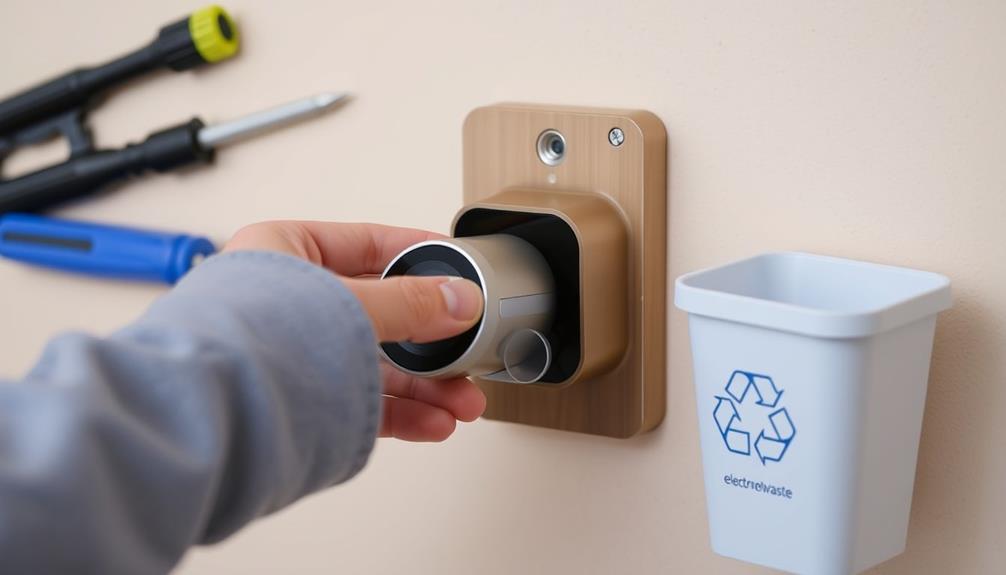To properly install your Ring Doorbell into a brick wall, the first step is to clean the surface and check for any loose mortar. Mark the location where you want to drill the pilot holes, making sure they are level. Use a masonry drill bit to drill the holes with precision, applying steady pressure. Insert plastic anchors into the holes for added stability. Align the doorbell with the anchors and securely fasten it in place with screws. If you are connecting wires, ensure they are properly attached before restoring power and testing the doorbell. By following these steps, you will be on your way to a successful installation, with plenty more to explore to ensure everything runs smoothly.
Key Takeaways
- Use a masonry drill bit to create pilot holes in the brick for secure installation without damaging the surface.
- Clean the brick surface thoroughly and inspect for any loose mortar or damage before mounting the doorbell.
- Mark the screw hole positions accurately, ensuring the doorbell is level and approximately 125 cm off the ground.
- Insert plastic anchor bolts into the drilled holes to provide stability for the screws that secure the Ring doorbell.
Tools Needed for Installation
To install your Ring doorbell on brick, you'll need a few essential tools to guarantee a smooth process.
First off, a masonry drill bit is critical. This specialized bit is designed to create pilot holes in hard brick without breaking, making it perfect for your installation.
You'll also need plastic anchors; these are fundamental for securing the screws in the brick, assuring your doorbell remains stable and secure once mounted.
Additionally, having a level tool on hand is significant. This will help you ascertain the doorbell is mounted straight, which is essential for achieving the best video angles. You don't want any crooked views!
For effective organization and a clutter-free working environment, consider utilizing smart organization techniques that can enhance your installation process.
You'll also need a screwdriver for tightening the screws that secure the Ring doorbell to the mounting bracket.
Finally, if you have an existing doorbell, you might need a box cutter or flathead screwdriver to remove its faceplate before you get started.
With these tools gathered, you're ready to take on the installation with confidence.
Preparing the Wall Surface

Before you start drilling, take a moment to assess the wall texture and verify it's suitable for mounting your Ring doorbell.
It's also a good idea to contemplate the tools and techniques required for a successful installation, as improper methods can lead to damage.
Clean the brick surface thoroughly to remove any dust or debris, which can affect adhesion.
Finally, mark the drill locations carefully to guarantee a precise installation.
What to look for in a home cleaning service can help you understand the importance of preparation in any project.
Assess Wall Texture
Evaluating the wall texture is important for determining the best approach to securely mount your Ring Doorbell on brick surfaces. Start by examining whether you're dealing with a smooth or textured brick. Smooth surfaces usually allow for easier drilling, while textured surfaces may need additional preparation or specialized tools to guarantee ideal adhesion. Additionally, confirming the wall is free from debris and moisture will enhance the mounting process, as 15 best garden hoses emphasize the importance of maintaining a clean work area.
Inspect the brick for any cracks or damage. If you find any issues, it's wise to repair them beforehand to enhance the stability of your installation. A solid foundation is essential for the longevity of your Ring Doorbell.
When you're ready to drill, consider using a masonry drill bit specifically designed for brick. This tool is critical for achieving precise holes that will accommodate the anchors securely. Using the right drill bit not only makes the process smoother but also guarantees a better fit for your mounting hardware.
Clean Brick Surface
Cleaning the brick surface is essential for guaranteeing a secure and lasting installation of your Ring Doorbell. Start by using a wire brush or masonry cleaner to eliminate any dirt, dust, or debris. This creates a clean brick surface for secure mounting. Inspect for loose mortar or crumbling bricks, and repair them to establish a stable foundation for your doorbell.
After cleaning, use a damp cloth to wipe down the area, removing any remaining dust that could interfere with the installation. Allow the surface to dry completely before moving forward. If your brick surface is uneven, consider applying a level compound to smooth it out, guaranteeing a reliable installation.
Here's a quick reference table for your cleaning process:
| Step | Action | Purpose |
|---|---|---|
| 1. Remove Debris | Use wire brush or masonry cleaner | Achieve a clean brick surface |
| 2. Inspect Surface | Check for loose mortar | Guarantee stable foundation for secure mounting |
| 3. Wipe Down | Use a damp cloth | Remove remaining dust |
| 4. Leveling | Apply level compound if needed | Create a smoother area for installation |
Following these steps will help you successfully install your Ring Doorbell.
Mark Drill Locations
To guarantee a precise installation, align your Ring Doorbell at about 125 cm from the ground and mark the drill locations with a pencil. This guarantees ideal placement and functionality. Use a level tool to keep everything straight. Carefully mark the positions for the mounting holes, confirming they match the design of the mounting bracket.
Consider these key points as you mark drill locations:
- Use a level tool to make sure your doorbell is perfectly aligned.
- Double-check your markings to prevent misalignment when creating the drill holes.
- Clean the marked areas to remove any debris or moisture, assuring proper anchoring.
Once you've marked your drill locations, you're ready to proceed with drilling. This preparation will help you achieve a secure installation and keep your Ring Doorbell functioning effectively. Remember, accuracy at this stage is vital to avoid any issues later on.
Drilling Techniques for Brick

When drilling into brick, using a masonry drill bit is vital to guarantee efficiency and prevent damage to the material. Standard drill bits simply won't cut it; they can dull quickly and become ineffective.
Begin your process by marking the desired hole locations with a pencil to assure accuracy.
Next, start with a small pilot hole. This initial hole guides the larger masonry drill bit and greatly reduces the risk of cracking the brick during drilling. As you drill, apply steady, even pressure. This technique keeps you in control and prevents overheating the bit, which can lead to further issues.
Once you've drilled through the brick, it's time to insert plastic anchor bolts into the holes. These anchors create a secure fit for the screws that will hold the Ring Doorbell in place. To secure the plastic anchor bolts in place, simply tap them into the drilled holes using a hammer until they are flush with the surface of the brick. Once the anchors are in place, it’s time to screw the Ring Doorbell onto the brick using the provided screws. Make sure to align the screw holes on the back of the device with the anchors before securely fastening the screws. With the screw ring doorbell in place, your Ring Doorbell should be securely attached to the brick and ready for use.
Mounting the Doorbell

Mounting your Ring Doorbell securely to the brick surface is essential for its functionality and longevity. Start by marking the positions for the screw holes, guaranteeing they align with your existing doorbell if you're replacing one.
Next, follow these steps to complete the installation process:
- Drill pilot holes using a masonry drill bit at the marked positions.
- Insert plastic anchor bolts into the drilled holes for added stability.
- Align the Ring Doorbell with the anchors, making sure everything is level.
Once mounted, double-check that the doorbell is firmly attached to the wall.
If you're using a Wasserstein Ring Doorbell Mount, it can help conceal any old doorbell holes, creating a more polished look.
Properly mounting your Ring Doorbell not only enhances its appearance but also guarantees peak performance, allowing you to enjoy the benefits of your smart home device for years to come.
Connecting Wires (Optional)

Connecting wires to your Ring Doorbell can help extend its battery life if you're using an existing doorbell chime. To do this, start by loosening the screws on the mounting bracket.
Wrap the wires from the chime around the appropriate terminals on the Ring Doorbell. Make certain the two wires don't touch each other to prevent short-circuiting, which could damage your device.
If your chime is digital, consult the installation instructions to find out if you need to include a diode. This component is necessary to protect your Ring Doorbell from potential damage.
Once you've secured the wires, gently tighten the screws to confirm a stable connection. Be cautious not to overtighten, as this could bend the mounting bracket.
If you're opting for a simpler setup without a chime, you can mount the Ring Doorbell as a battery-operated device without connecting any wires. This option is convenient if you prefer not to deal with wiring.
Restoring Power and Testing

After securing your Ring Doorbell, you'll need to restore power by flipping the breaker back on.
Once that's done, test the device by pressing the button to see if it sends alerts to your phone.
If your setup includes a chime, make sure it rings as well, ensuring everything's working correctly.
Restore Power Safely
How do you safely restore power to your Ring Doorbell after installation? Start by locating your home's breaker box. Once you find it, flip the switch back on to restore power safely. After doing this, you'll want to verify everything's working as intended.
Here's what to check:
- Confirm the Ring Doorbell powers on and connects to your Wi-Fi network.
- Press the doorbell and check if the existing chime activates.
- If you're using a digital chime, verify the diode is installed correctly; reversing it may be necessary for functionality.
Taking these steps not only verifies your doorbell is functional but also that it's properly installed. By restoring power safely and checking all connections, you can enjoy the peace of mind that comes with enhanced home security.
Now that you've secured the Ring Doorbell, you're one step closer to complete installation!
Test Device Functionality
Once you've restored power to your Ring Doorbell, it's time to test its functionality and confirm everything's working smoothly. Start by pressing the doorbell button. If it activates correctly and your existing chime sounds, you're in good shape. If the chime doesn't activate, check the connections to make sure they're secure. You might need to reverse the diode if you're using a digital chime.
Next, verify that you can access the live video feed through the Ring app. This confirms that the device is connected to Wi-Fi and functioning properly. Regularly testing the device after installation is essential to confirm it continues to operate as expected.
| Action | Result |
|---|---|
| Press Doorbell Button | Should activate chime or camera |
| Check Connections | Make sure all wires are secure |
| Reverse Diode (if needed) | Necessary for digital chimes |
| Access Live Video Feed | Confirms Wi-Fi connection |
| Regular Testing | Confirms ongoing functionality |
Verify Chime Activation
To verify chime activation, restore power by flipping the breaker switch back on, then press the doorbell button to see if the chime rings correctly. If you hear the chime, congratulations! Your Ring Doorbell is successfully installed and functioning. If it doesn't ring, you may need to troubleshoot.
Check the following:
- Confirm the breaker is fully flipped on.
- Confirm the wiring connections are secure and properly connected.
- If you have a digital chime, verify that a diode is installed as per the instructions.
If you still experience issues, revisit the wiring connections to confirm everything is properly in place. Loose or incorrectly connected wires can prevent your chime from activating.
Once everything's confirmed and the chime rings as expected, finalize your installation by securing the faceplate of the Ring Doorbell with the included security screws. This will protect your device and confirm it stays in place.
With these steps, you can confidently enjoy the functionality of your Ring Doorbell!
Setting Up the Ring App

Setting up the Ring app is essential for optimizing your doorbell's functionality and guaranteeing you stay connected to your home. Start by downloading the Ring app from the App Store or Google Play Store. If you're new, create your Ring account by following the on-screen prompts. If you already have an account, simply log in.
Once you're logged in, use the included instructions to connect your Ring Doorbell to your Wi-Fi network. Make sure you have your Wi-Fi credentials ready, as you'll need them for this step.
After connecting, you can customize your notification preferences within the app. This allows you to receive alerts for motion detection or doorbell presses, so you'll never miss a visitor.
The Ring app also enables you to access the live video feed, adjust settings like motion sensitivity, and set recording times.
To guarantee you're benefiting from the latest features and security enhancements, make it a habit to keep the Ring app updated. If you have questions while setting up, you can easily find an answer through the app's help section.
Enjoy the peace of mind that comes from being connected!
Troubleshooting Common Issues

Troubleshooting common issues with your Ring Doorbell can help you maintain its functionality and guarantee you're always connected to your home. Here are some common problems you might encounter and their solutions:
- Drilling difficulties: If you struggle drilling into hard brick, make sure you're using a masonry drill bit designed for that purpose.
- Misaligned doorbell: If your doorbell seems off, loosen the screws, adjust its position, and retighten.
- Connectivity issues: Check if your doorbell is within range of your Wi-Fi router. If not, consider relocating your router or using a Wi-Fi extender.
If your battery isn't charging or lasting as expected, inspect the cable and port for damage. Ensuring everything is properly seated can prevent further issues.
Frequently Asked Questions
Should You Drill Into Brick or Mortar for a Doorbell?
When deciding whether to drill into brick or mortar for your doorbell, you should consider ease and potential damage.
Mortar's generally easier to drill into and allows for repairs if needed, making it a more forgiving option.
If you choose brick, use masonry drill bits and plastic anchors for a secure fit, but be prepared for more effort.
Can I Glue Doorbell to Brick?
Gluing a doorbell to brick is like trying to hold the ocean back with a sandcastle—it's not gonna last!
While you might think adhesives can work, they often lack the strength and stability needed for long-term use.
Uneven surfaces and weather conditions can lead to failure.
Instead, consider drilling into mortar or using anchors for a secure mount that won't leave you ringing in frustration later on.
How Do You Screw a Screw Into Brick?
To screw a screw into brick, start by drilling a pilot hole using a masonry drill bit.
Make sure the hole's slightly smaller than the screw for a snug fit.
Insert plastic anchors into the holes for added grip, since brick can be tough for screws alone.
Use masonry screws like Tapcon, and drill slowly to prevent overheating.
How Do You Use a Ring Doorbell Without a Drill Mount?
You want convenience without the hassle of drilling.
Using a Ring Doorbell without a drill mount's possible! You can opt for the official no-drill mount, which uses waterproof tape, or try a DIY method with industrial-strength double-sided tape for a custom grip.
Just guarantee the brick surface is smooth for best adhesion.
Conclusion
Now that you've successfully mounted your Ring doorbell, you can enjoy the peace of mind that comes with knowing who's at your door, even when you're not home.
Isn't it great to have that kind of security at your fingertips?
Remember to regularly check the app for updates, and don't hesitate to refer back to these steps if you encounter any issues.
With your doorbell in place, you're one step closer to a smarter home!









